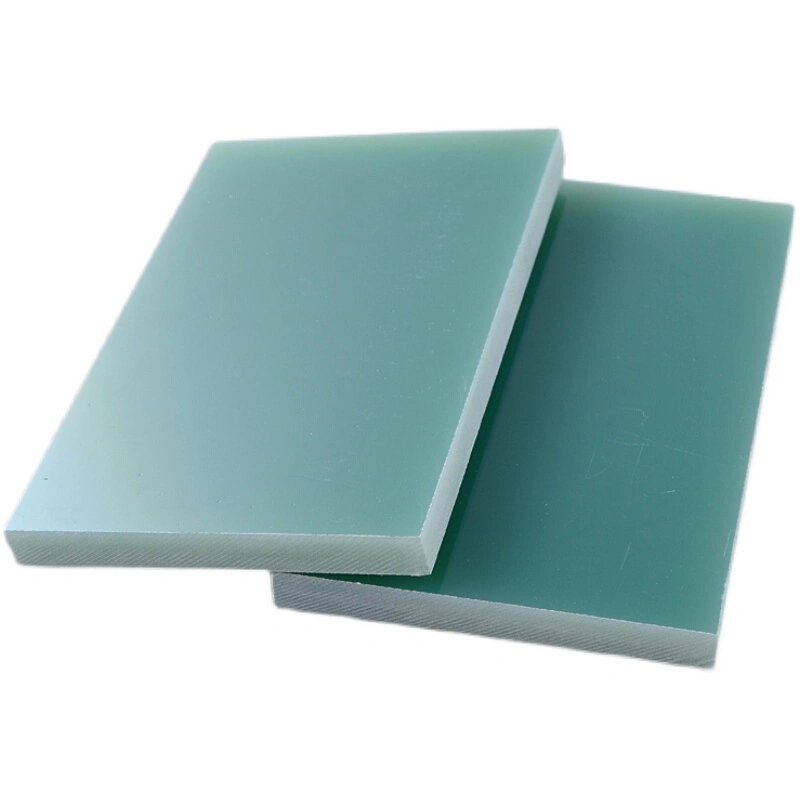Composition and Manufacturing Process of FR4 Epoxy Sheet
Raw Materials and Their Properties
FR4 epoxy sheet is a composite material consisting of two primary components: fiberglass reinforcement and epoxy resin. The fiberglass provides strength and dimensional stability, while the epoxy resin acts as a binder and contributes to the material's electrical and thermal properties. The combination of these materials results in a substrate with excellent mechanical strength, electrical insulation, and flame-retardant characteristics.
The fiberglass used in FR4 epoxy board is typically E-glass, known for its high tensile strength and resistance to electrical current flow. The epoxy resin is a thermosetting polymer that, when cured, creates a strong, durable, and chemically resistant matrix. The epoxy resin also contains flame-retardant additives, which give FR4 its fire-resistant properties.
Manufacturing Techniques
The production of FR4 epoxy sheet involves a multi-step process that ensures consistent quality and performance. The manufacturing process typically includes the following stages:
- Prepreg preparation: Fiberglass cloth is impregnated with epoxy resin to create prepreg sheets.
- Layering: Multiple layers of prepreg are stacked to achieve the desired thickness.
- Lamination: The stacked layers are subjected to heat and pressure in a lamination press.
- Curing: The laminated material undergoes a controlled curing process to fully cross-link the epoxy resin.
- Finishing: The cured sheets are trimmed, sanded, and inspected for quality control.
Quality Control Measures
To ensure consistent performance and reliability, FR4 epoxy sheet manufacturers implement rigorous quality control measures throughout the production process. These measures include:
- Raw material testing to verify the properties of fiberglass and epoxy resin
- In-process inspections during prepreg preparation and lamination
- Non-destructive testing techniques such as ultrasonic scanning to detect internal defects
- Physical and electrical property testing of finished sheets
- Dimensional and surface quality checks
Processing Performance of FR4 Epoxy Sheet
Machining Capabilities
FR4 epoxy sheet exhibits excellent machining characteristics, making it suitable for a wide range of fabrication processes. The material can be easily cut, drilled, milled, and routed using conventional woodworking and metalworking tools. However, due to its abrasive nature, carbide-tipped or diamond-coated tools are recommended for optimal performance and tool life.
Some key machining capabilities of FR4 epoxy board include:
- Precision cutting using CNC routers or water jet cutters
- Drilling of small-diameter holes with minimal burr formation
- Milling of complex shapes and profiles
- Tapping and threading for mechanical fasteners
- Edge finishing through sanding or chamfering
Thermal and Chemical Resistance
FR4 epoxy sheet demonstrates excellent thermal and chemical resistance, contributing to its versatility in various applications. The material maintains its mechanical and electrical properties over a wide temperature range, typically from -65°C to 130°C. This thermal stability makes FR4 suitable for use in harsh environments and applications involving temperature fluctuations.
In terms of chemical resistance, FR4 epoxy board exhibits good resistance to:
- Weak acids and bases
- Organic solvents
- Oils and greases
- Moisture and humidity
However, it's important to note that prolonged exposure to strong acids or bases may degrade the material over time.
Laminating and Bonding Properties
FR4 epoxy sheet demonstrates excellent laminating and bonding properties, making it ideal for multi-layer constructions and composite assemblies. The material can be easily bonded to itself or other substrates using various adhesives, including epoxy-based adhesives, acrylic adhesives, and pressure-sensitive tapes.
Key aspects of FR4's laminating and bonding properties include:
- Compatibility with a wide range of adhesives and bonding methods
- Ability to create multi-layer structures for complex PCB designs
- Good surface energy for optimal adhesive wetting and bond strength
- Compatibility with copper foil lamination for PCB manufacturing
- Suitability for vacuum forming and pressure forming processes
Applications of FR4 Epoxy Sheet
Electronics and PCB Manufacturing
The most prevalent application of FR4 epoxy sheet is in the electronics industry, particularly in the manufacture of printed circuit boards (PCBs). FR4's combination of electrical insulation, mechanical strength, and thermal stability makes it an ideal substrate for PCBs used in a wide range of electronic devices. Some specific applications in this field include:
- Multilayer PCBs for complex electronic systems
- High-frequency circuit boards for telecommunications equipment
- Rigid-flex PCBs for space-constrained applications
- Power supply and distribution boards
- Backplanes and motherboards for computer systems
Aerospace and Defense Industries
The aerospace and defense sectors leverage the exceptional properties of FR4 epoxy board for various applications. The material's lightweight nature, coupled with its strength and flame-retardant characteristics, make it suitable for use in aircraft, satellites, and military equipment. Some notable applications include:
- Structural components in aircraft interiors
- Radomes and antenna housings
- Electrical insulation panels in avionics systems
- Composite structures for unmanned aerial vehicles (UAVs)
- Thermal insulation in spacecraft
Industrial and Automotive Applications
FR4 epoxy sheet finds numerous applications in industrial and automotive sectors due to its versatility and robust performance. Its ability to withstand harsh environments and maintain dimensional stability makes it suitable for various components and structures. Some industrial and automotive applications include:
- Electrical enclosures and switch panels
- Insulation components in electric motors and transformers
- Structural elements in automotive electronics
- Gaskets and seals for industrial equipment
- Wear-resistant linings in material handling systems
Conclusion
FR4 epoxy sheet has established itself as a versatile and indispensable material across various industries due to its exceptional processing performance and wide-ranging applications. Its unique combination of electrical insulation, mechanical strength, and thermal stability makes it particularly valuable in electronics, aerospace, and industrial sectors. As technology continues to advance, the demand for high-performance materials like FR4 epoxy board is expected to grow, driving further innovations in manufacturing processes and applications. The ongoing development of FR4 and related composites will undoubtedly play a crucial role in shaping the future of electronics and advanced manufacturing.
Contact Us
If you're interested in learning more about FR4 epoxy sheet and how it can benefit your projects, we invite you to contact us at info@jhd-material.com. Our team of experts is ready to assist you with product information, technical support, and customized solutions tailored to your specific needs.
References
Smith, J. (2022). Advanced Composite Materials in Electronics: Properties and Applications. Journal of Electronic Materials, 51(3), 1245-1260.
Johnson, A., & Brown, T. (2021). Manufacturing Processes for FR4 Epoxy Laminates: A Comprehensive Review. Composites Manufacturing, 18(2), 78-95.
Lee, C., et al. (2023). Thermal and Mechanical Properties of FR4 Epoxy Composites for High-Performance PCB Applications. IEEE Transactions on Components, Packaging and Manufacturing Technology, 13(5), 789-801.
Wang, Y., & Zhang, L. (2022). Recent Advances in FR4 Epoxy Sheet Processing for Aerospace Applications. Aerospace Materials and Technology, 9(4), 412-428.
Garcia, M., et al. (2021). Comparative Study of FR4 and Alternative Substrate Materials for Next-Generation Electronics. Journal of Materials Science: Materials in Electronics, 32(8), 10235-10250.
Thompson, R. (2023). Innovations in FR4 Epoxy Board Fabrication: Challenges and Opportunities. Advanced Manufacturing Processes, 14(3), 567-582.






